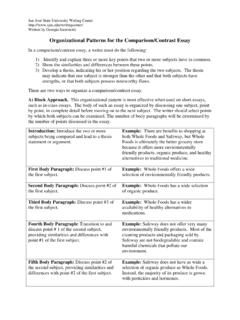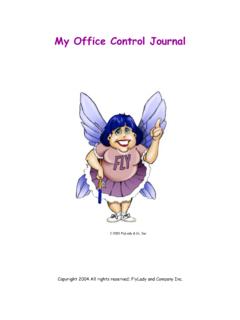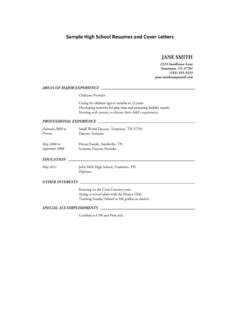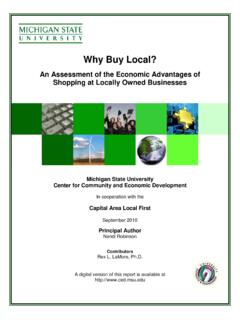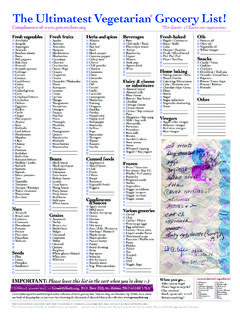Transcription of Retail Management - Tutorialspoint
1 Retail Management i About the Tutorial Retail Management is an activity of selling products or services to their end-users. This tutorial introduces you to various concerns of Retail business such as Retail marketing, space Management , and Retail operations. It also introduces you to visual merchandising, Retail marketing mix, and e-tailing. Audience This tutorial is prepared keeping in mind the need of beginners who are keen to make a career in Retail Marketing and Operations. For all other enthusiastic readers, this tutorial is a good learning material. Prerequisites We assume the reader has a basic knowledge of business administration and marketing concepts. Creativity, analytical thinking, strategic thinking, and communication skill are a plus.
2 Disclaimer & Copyright Copyright 2015 by Tutorials Point (I) Pvt. Ltd. All the content and graphics published in this e-book are the property of Tutorials Point (I) Pvt. Ltd. The user of this e-book is prohibited to reuse, retain, copy, distribute or republish any contents or a part of contents of this e-book in any manner without written consent of the publisher. We strive to update the contents of our website and tutorials as timely and as precisely as possible, however, the contents may contain inaccuracies or errors. Tutorials Point (I) Pvt. Ltd. provides no guarantee regarding the accuracy, timeliness or completeness of our website or its contents including this tutorial. If you discover any errors on our website or in this tutorial, please notify us at Retail Management ii Table of Contents About the Tutorial.
3 I Prerequisites .. i Disclaimer & Copyright .. i Table of Contents .. ii PART 1: RETAILING BASICS .. 1 1. Retailing Overview .. 2 What is Retail ? .. 2 Classification of Retailing Formats .. 4 Product Retailing versus Service Retailing .. 6 Retail versus Wholesale .. 7 Retail 7 Evolution of Retail .. 8 2. Retail Sectors .. 10 Food .. 10 Clothing & Textile .. 11 Consumer Durables .. 11 Footwear .. 12 Jewelry .. 13 Books-Music-Gift Articles .. 14 Fuel .. 14 3. Retail Challenges & Theories .. 15 Threat of New Competitors .. 15 Threat of Substitutes .. 16 Bargaining Power of Buyers .. 17 Bargaining Power of Suppliers .. 17 Intensity of Rivalry among Existing Competitors .. 18 Theories of Development .. 18 4. Understanding Retail Consumer.
4 20 Consumer versus 20 Customer s Buying Behavior Patterns .. 21 Factors Influencing Retail Consumer .. 23 Consumer s Decision Making Process .. 25 PART 2: INSIDE Retail Management .. 27 5. Retail Market Segmentation & Strategies .. 28 What is a Market Segmentation? .. 28 Types of Retail Markets .. 28 What is Retail Strategy? .. 29 Strategies for Effective Market Segmentation .. 29 Strategies for Market Penetration .. 30 Growth Strategies .. 30 Retail Management iii 6. Retail Business Location .. 32 Importance of Location in Retail 32 Trade Area: Types of Business Locations .. 32 Factors Determining Retail Locations .. 35 Steps to Choose the Right Retail Location .. 36 Measuring the Success of Location .. 36 7. Merchandise Management .
5 38 What is Merchandising? .. 38 Factors Influencing Merchandising .. 38 Functions of a Merchandising Manager .. 39 Merchandise Planning .. 39 Merchandise Buying .. 40 Merchandise Performance .. 41 8. Retail Business 42 Store Management .. 42 Premises Management .. 43 Inventory Management .. 44 Receipt Management .. 44 Supply Chain Management and Logistics .. 45 Customer Service .. 45 9. Retail Space Management .. 47 What is Space Management ? .. 47 Optimum Space Use .. 47 Retail Floor Space .. 48 Store Layout and Design .. 48 Store Design .. 51 PART 3: Retail SELLING .. 53 10. Retail Pricing .. 54 What is Retail Pricing? .. 54 Factors Influencing Retail Prices .. 54 Demand-Oriented Pricing Strategy .. 55 Cost-Oriented Pricing Strategy.
6 56 Competition-Oriented Pricing Strategy .. 57 Differential Pricing Strategy .. 57 11. Retail Marketing .. 58 Visual Merchandising .. 58 Retail 58 Sales Promotions .. 59 Customer Relationship Management (CRM) .. 60 Elements of Retail Marketing Mix (7Ps) .. 61 Retail Communication .. 62 Retail Management iv 12. Emerging Trends in Retail .. 63 Changing Nature of Retailing .. 63 Modern Retail Formats .. 63 E-Tailing .. 64 Retail Management 1 Part 1: Retailing Basics Retail Management 2 "In my whole retailing career, I have stuck to one guiding principle: give your customers what they customers want everything: a wide assortment of good quality merchandise, lowest possible prices, guaranteed satisfaction with what they buy, friendly knowledgeable service, convenient hours, free parking, and a pleasant shopping experience.
7 You love it when you visit a store that somehow exceeds your expectations and you hate it when a store inconveniences you, or gives you hard time, or just pretends you are " Sam Walton (Founder, Walmart) In the complex world of today, the consumer is king and retailers are keener on consumer satisfaction. Considering the busy lifestyles of today s consumers, the retailers also provide services apart from products. Retailing occupies a very important place in the economics of any country. It is the final stage of distribution of product or service. It not only contributes to country s GDP but also empowers a large number of people by providing employment. Retail Management starts with understanding the term ' Retail '.
8 What is Retail ? Retailing includes all activities involved in selling goods or services to the final consumers for personal, non-business use. - Phillip Kotler Any organization that sells the products for consumption to the customers for their personal, family, or household use is in the occupation of retailing. Functions of a Retailor Retailor provides the goods that customer needs, in a desired form, at a required time and place. A retailor does not sell raw material. He sells finished goods or services in the form that customer wants. A retailer buys a wide range of products from different wholesalers and offers the best products under one roof. Thus, the retailor performs the function of both buying and selling.
9 A retailor keeps the products or services within easy reach of the customer by making them available at appropriate location. 1. RETAILING OVERVIEW Retail Management 3 Retail in Marketing Channels With industrialization and globalization, the distance between the manufacturer and the consumer has increased. Many times a product is manufactured in one country and sold in another. The levels of intermediaries involved in the marketing channel depends upon the level of service the consumer desires. Type A and B: Retailers. For example, Pantaloons, Walmart. Type C: Service Providers. For example, Eureka Forbes. Retail Management 4 Classification of Retailing Formats The retailing formats can be classified into following types as shown in the diagram: Ownership Based Retailing Let us see these retailers in detail: Independent Retailers: They own and run a single shop, and determine their policies independently.
10 Their family members can help in business and the ownership of the unit can be passed from one generation to next. The biggest advantage is they can build personal rapport with consumers very easily. For example, stand-alone grocery shops, florists, stationery shops, book shops, etc. Chain Stores: When multiple outlets are under common ownership it is called a chain of stores. Chain stores offer and keep similar merchandise. They are spread over cities and regions. The advantage is, the stores can keep selected merchandise according to the consumers preferences in a particular area. For example, Westside Stores, Shopper s Stop, etc. Franchises: These are stores that run business under an established brand name or a particular format by an agreement between franchiser and a franchisee.











